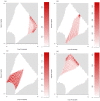Experiments in globalisation, food security and land use decision making
- PMID: 25437010
- PMCID: PMC4250087
- DOI: 10.1371/journal.pone.0114213
Experiments in globalisation, food security and land use decision making
Abstract
The globalisation of trade affects land use, food production and environments around the world. In principle, globalisation can maximise productivity and efficiency if competition prompts specialisation on the basis of productive capacity. In reality, however, such specialisation is often constrained by practical or political barriers, including those intended to ensure national or regional food security. These are likely to produce globally sub-optimal distributions of land uses. Both outcomes are subject to the responses of individual land managers to economic and environmental stimuli, and these responses are known to be variable and often (economically) irrational. We investigate the consequences of stylised food security policies and globalisation of agricultural markets on land use patterns under a variety of modelled forms of land manager behaviour, including variation in production levels, tenacity, land use intensity and multi-functionality. We find that a system entirely dedicated to regional food security is inferior to an entirely globalised system in terms of overall production levels, but that several forms of behaviour limit the difference between the two, and that variations in land use intensity and functionality can substantially increase the provision of food and other ecosystem services in both cases. We also find emergent behaviour that results in the abandonment of productive land, the slowing of rates of land use change and the fragmentation or, conversely, concentration of land uses following changes in demand levels.
Conflict of interest statement
Figures








References
-
- McKenzie LW (1953) Specialisation and efficiency in world production. Review Econ Studies 21(3):165–180.
-
- Hertel TW (2011) The Global Supply and Demand for Agricultural Land in 2050: A Perfect Storm in the Making? Am J Agr Econ 93(2):259–275.
-
- Hay DA (2001) The Post-1990 Brazilian Trade Liberalisation and the Performance of Large Manufacturing Firms: Productivity, Market Share and Profits. The Economic Journal 111(473):620–641.
-
- Thangavelu SM, Toh M-H (2005) Bilateral “WTO-Plus” Free Trade Agreements: The WTO Trade Policy Review of Singapore 2004. The World Economy 28(9):1211–1228.
Publication types
MeSH terms
LinkOut - more resources
Full Text Sources
Other Literature Sources

